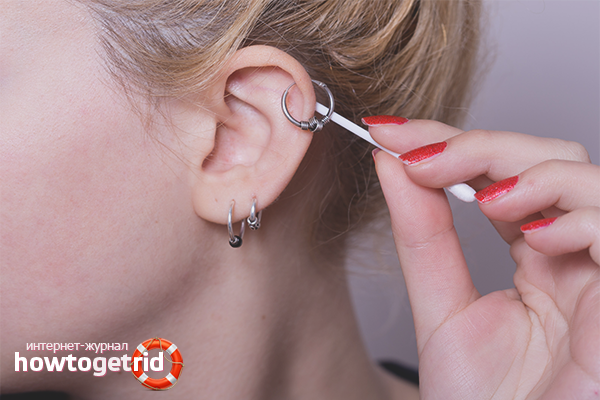The content of the article
Beauty salons and piercing studios offer their clients to pierce their ears with professional tools. As a rule, the procedure is carried out with the use of a “pistol”, into which the earring is fixed. However, many people prefer to pierce their ears in the old fashioned way at home. The process requires a certain skill and attention to detail. Due to lack of experience, there is a risk of infection, and therefore the earlobes can fester. We will highlight important aspects and provide step-by-step instructions.
Necessary tools for ear piercing
- For the procedure, you will need to purchase sterile needles. Such tools are equipped with an empty center, thanks to which the earring is easily inserted. The devices are sold in tattoo and piercing salons.
- At home, many housewives prefer to pierce the earlobes with a pin. Such a move will prevent the tool from slipping in the hands, as can happen with a needle. A specialty store sells a sterile piercing kit, it makes sense to consider this option.
- Important attention should be paid to earrings. After a puncture, special carnations are inserted into the ear, which have a thin end, but a wide center. Such products help to form a hole for jewelry, which will be put on in the future.
- Prefer earrings of pure silver or gold, surgical steel, medical alloy. Such jewelry practically does not contain nickel - the strongest allergen.
- Take care in advance of disinfectants, such as medical alcohol, peroxide, vodka or regular cologne. You will need these funds to sterilize your hands, earlobes and instruments.
- To pierce the ears at home, you need a clean school eraser, a piece of potato or apple, a cork from champagne / wine, or a third of a bar of soap.One of the listed components serves as a pillow against which the needle rests on the back of the lobe.
Step number 1. Sterilize tools
If you are not using a special sterile device for piercing the ears, but a needle or a pin, you must first sterilize the instruments.
- The procedure can be carried out using a lighter: hold the needle over an open fire for 10-15 seconds, cool. After that, moisten the cosmetic sponge in hydrogen peroxide, "chlorhexidine" or medical alcohol, wipe the needle.
- Spread a paper towel on a flat surface, place a tool on it and let it dry. Do not touch the tip of the needle until you pierce your ears.
- Sterilize the earrings. To do this, pour a solution of hydrogen peroxide or alcohol into the container, send the product to the liquid, leave for 3-5 minutes. After the expiration date, place the earrings on a paper towel next to the needle (until completely dry).
- Before sterilization of jewelry it is desirable to detach the clasps from the main part. Such a move will help you quickly put the earrings in your ears and fix them on the lobe.
- It is important to understand that the above methods do not guarantee 100% protection against bacteria. If possible, purchase a special piercing kit, it already includes sterilized products and instruments.
Step number 2. Prepare the ears for the procedure.
Before piercing the ears, they must be treated with an antiseptic. Otherwise, the bacteria will enter the cavity of the wound and the lobes will begin to fester.
- Dip a cosmetic swab in a solution of hydrogen peroxide (concentration of 3-6%), medical alcohol, vodka or "chlorhexidine".
- Squeeze a cotton pad, wipe them earlobes. Repeat the procedure 2-3 times, replacing the used sponge clean. If possible, purchase a special antiseptic gel "Bastin", which is sold in piercing salons.
- Let your skin dry before piercing your ears. During this period, all bacteria will die, so you eliminate the risk of infection.
- After sterilizing the ears, it is necessary to mark the points on the cheeks at which the holes will be located. For these purposes, use a ballpoint pen or felt-tip pen, the main thing is to observe symmetry.
- Now you need to anesthetize the ears so that the procedure goes unnoticed.This will help the ice cubes, rub them lobes for 2-3 minutes.
- It is important to understand that the cold does not affect the skin in the most favorable way. The lobes will become stiff, so the piercing process can be difficult.
- You can use a special anesthetic gel that is rubbed into the skin. The composition is sold in the salon of tattoo masters, piercing studios and a pharmacy.
Step number 3. Pierce ears
After the necessary preparatory activities can proceed to the procedure.
- To begin, wash your hands with soap and water, dry them with a towel, in any case do not apply the cream, otherwise the needle will slide in your hands.
- Treat your hands with a special antiseptic, which includes alcohol. If desired, you can skip this step by wearing sterile medical gloves (carefully choose the size).
- Cut a small piece of antibacterial soap from the bar, attach it to the back of the lobe. Hold it as tightly as possible so that the tip of the tool goes inside after a puncture.
- If desired, you can replace the soap bar with a slice of green apple or a wine / champagne cork.After fixing the back wall, bring the needle to the intended puncture site.
- It is important that the pin or needle is perpendicular (90 degrees) to the ear lobe. Otherwise, the piercing will look asymmetric, ugly.
- The needle must be inserted in such a way that the puncture is carried out directly above the target point.
- Now inhale, then in one sharp motion push the needle into the skin so that it sticks into the soap bar on the back of the ear.
- If you have not used an anesthetic gel or ice, your ear will begin to pinch and turn red. The procedure can not be called painful.
- Soak the instrument in the earlobe for 1 minute, move the needle clockwise to prepare the hole for inserting the earring. Repeat with the second ear.
- Pull out the needle, pull the earlobe, insert the earrings and fasten them. Wipe the lobe with a cotton sponge soaked in hydrogen peroxide or medical alcohol.
Ears after piercing
After the procedure it is very important to ensure the safety of yourself. Otherwise, there is a risk of infection in the wound, which will lead to inflammation and inflammation. Observe preventive measures.
- Do not remove the earrings within 1-1.5 months after the procedure. During this period, the wounds will be completely tightened, as a result of which you will not irritate the puncture site by inserting and removing the earrings.
- Treat the earlobes around the piercing daily to avoid infection. For effective cleansing, use bactericidal, anti-inflammatory or antiseptic solutions. These include medical alcohol, vodka, a solution of sea salt and soda, hydrogen peroxide, “Chlorhexidine”, “Miramistin”, etc.
- To disinfect the wound, moisten the cosmetic sponge in the selected composition, wipe the earlobe with it. Then apply the product on a cotton swab, do not squeeze. Treat the skin around the puncture, moving the earring back slightly. If the vial allows, try pouring some of the compound directly into the wound. Such manipulations must be carried out on both sides of the lobe.
- On the Internet, you can find a lot of recommendations that say, then earrings need to scroll in your ears every day until the moment of healing. However, we do not advise doing this, since the process will significantly increase the duration of healing.So that the product does not grow together with the skin, it is enough to scroll it once a week. Rest of the rest of the time with antiseptic treatment, dripping it into the wound cavity.
- It is important to understand that carrying out piercing at home implies the risk of infection. In this case, the main thing is to take the necessary measures in time so that the bacteria do not grow. Compress will help you with the procedure: pour 200 ml into a sterile container. boiling water, add 30 gr. soda and 20 gr. salt, stir to dissolve the crystals. Fold sterile gauze in 5 layers, soak it in the product, cool it and put it on the ear on both sides. After this, treat the wound with peroxide, apply a cream with local antibiotics. If there is no improvement during the day, go to see a therapist.
Practical recommendations
- In cases when titanium or medical (made of surgical steel) earrings are inserted into the ears after a puncture, there is no need to turn them at all. Your actions can cause the infection to penetrate the wound cavity, causing inflammation. In addition, the duration of healing will increase by 2-2.5 times.
- If there is a goal - pierce several holes in one ear, carry out the procedure in stages. First make one hole, let it heal. Only after that proceed to the second, third puncture.
It is easy to pierce the ears at home, if you have sufficient knowledge regarding the procedure. First, prepare the necessary tools and materials, disinfect them. Mark the puncture site with a marker, place a piece of apple behind the lobe. Stick the needle at a right angle, stand for half a minute, insert the earrings.
Video: how to pierce the ears of the child "gun"












To send